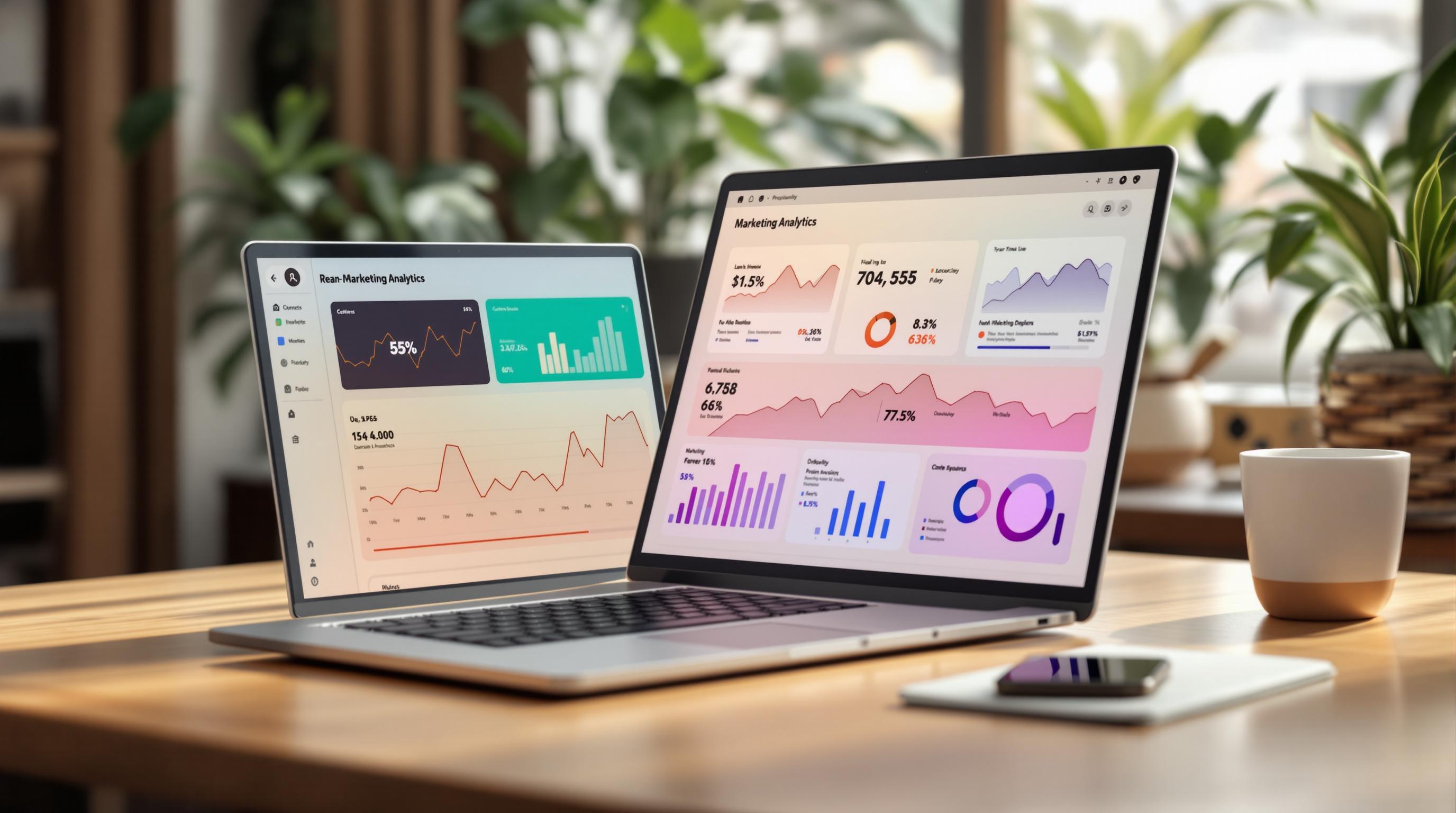Want to predict customer intent in real time? These tools help businesses analyze live data like website visits, search behavior, and social media interactions to deliver personalized experiences and boost conversions. Here’s a quick rundown of the top tools for real-time intent prediction:
- MeetRecord: AI-powered insights from sales calls to track customer sentiment and objections.
- UpLead: B2B lead generation with access to 160M+ leads and intent data integration.
- Bombora: Tracks B2B behavior across 5,000+ platforms to identify purchase intent.
- ZoomInfo: Monitors intent across 12,000+ topics with a database of 104M companies.
- Demandbase: Focused on account-based marketing with advanced intent tracking.
- Lead Forensics: Identifies anonymous website visitors and provides contact details.
- Triblio ABM Platform: Combines intent data with first-party insights for ABM strategies.
Quick Comparison
| Tool | Best For | Key Strengths | Pricing Range | Target Business Size |
|---|---|---|---|---|
| MeetRecord | Sales teams | AI call analysis, CRM integration | Contact for quote | Small to mid-sized |
| UpLead | Lead generation | Verified leads, intent data | $74–$299/month | Small to enterprise |
| Bombora | B2B intent data | Broad data network, conversion boost | Contact for quote | Mid-sized to enterprise |
| ZoomInfo | Sales intelligence | Extensive database, CRM integration | ~$15,000+/year | Mid-sized to enterprise |
| Demandbase | Account-based marketing | ABM-focused platform | $1,000+/month | Enterprise |
| Lead Forensics | Website visitor identification | Real-time tracking, lead scoring | ~$6,000–$98,000/year | Mid-sized businesses |
| Triblio | ABM strategies | Multi-channel campaign management | Contact for quote | Mid-sized to enterprise |
These tools cater to different business needs, from small teams to large enterprises. Whether you’re focusing on lead generation, sales intelligence, or account-based marketing, there’s a solution tailored to your goals.
How to use intent data to maximize your marketing impact
1. MeetRecord
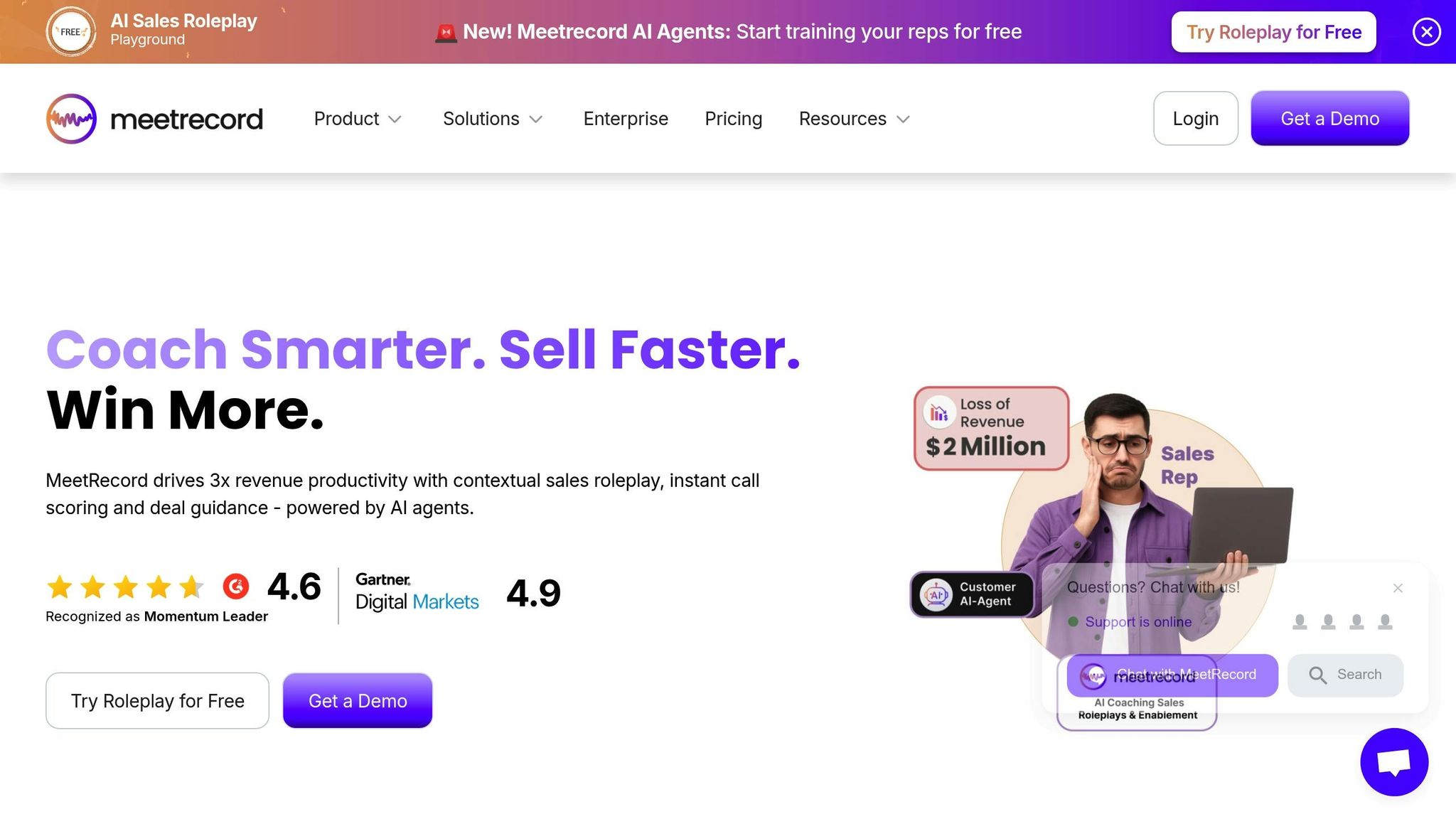
MeetRecord is an AI-powered revenue intelligence platform designed to capture and interpret customer intent during sales conversations in real time. By automatically recording, transcribing, and analyzing sales calls, it pinpoints key discussion points, customer sentiment, and potential objections. This conversational intelligence helps marketing teams gain a deeper understanding of what prospects are thinking and feeling throughout the sales journey.
Key Features for Understanding Intent
One of MeetRecord's standout qualities is its ability to delve into buyer psychology. It identifies influencers and blockers within prospect organizations and offers real-time, AI-driven talk tracks to guide conversations based on live analysis.
Another notable feature is the AI Sales Roleplay, which prepares sales teams for common objections by simulating real-world scenarios and providing instant feedback. This tool equips teams with the skills to respond effectively to customer intent signals, ultimately driving better sales outcomes.
Proven Results
MeetRecord’s focus on intent prediction has delivered measurable results for many companies:
-
Coverflex improved engagement by 35% using the platform’s AI insights. Co-Founder Luis Rocha shared:
"MeetRecord has been invaluable in improving our sales process and closing more deals. The best thing is that it allows our sales team to record demos and review them before the second meeting."
- Omneky reduced sales rep ramp-up time by 50% through MeetRecord's AI coaching capabilities.
-
GoRamp doubled its deal predictability, with Head of Sales Dovydas Cincius stating:
"MeetRecord's AI capabilities have significantly improved our ability to find specific information quickly, leading to better deal predictability and overall sales efficiency."
Seamless Integration
MeetRecord integrates effortlessly with popular CRMs like HubSpot, Salesforce, and Pipedrive, as well as communication tools such as Zoom, Microsoft Teams, and Google Meet. This ensures that intent insights, meeting summaries, and deal health scores are automatically synced into existing workflows.
One user praised this functionality:
"Our favorite feature of MeetRecord is that the post-meeting recaps and summaries automatically appear in HubSpot. We attempted to set up the same functionality with Microsoft Teams Premium but were unsuccessful." - Mikeorlando D., Director of Operations
Pricing and User Feedback
MeetRecord offers customized pricing tailored to the size and needs of each business. Every plan includes a 14-day free trial and 24/5 support. With a 4.9/5 rating on Capterra, the platform is frequently lauded for its customer service and overall value.
Users appreciate the clean interface and AI-generated summaries. However, some have noted occasional delays in dashboard loading times. Given its robust feature set, MeetRecord is particularly well-suited for larger sales teams (3+ members) that require an enterprise-level solution.
For marketing teams seeking to understand customer intent through direct conversations rather than digital activity alone, MeetRecord offers a powerful tool to enhance personalization and optimize campaign timing.
2. UpLead
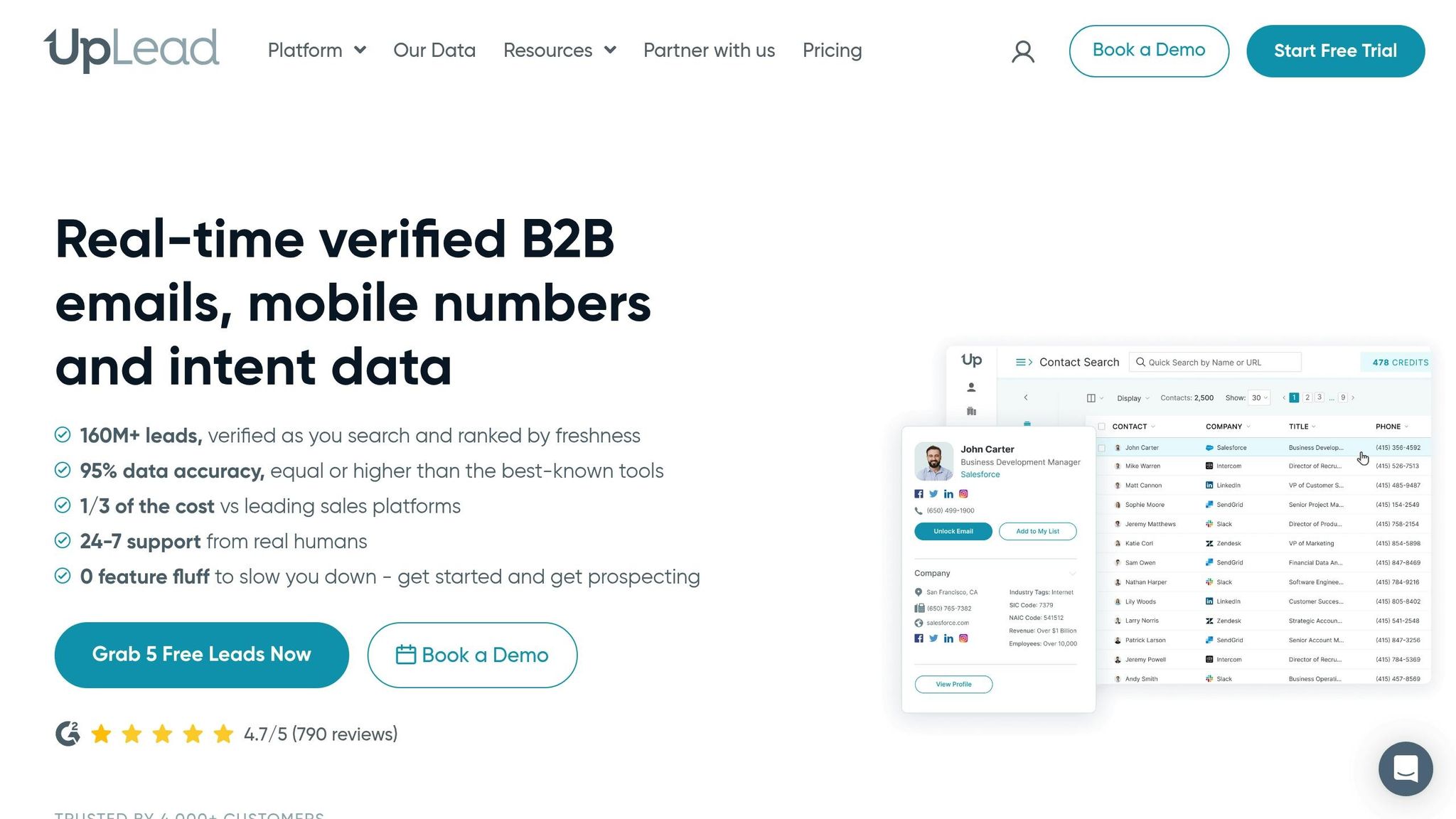
UpLead is a B2B lead generation platform designed to identify potential customers actively searching for solutions. With access to a database of over 160 million leads and a 95% data accuracy guarantee, UpLead ensures businesses connect with prospects who show genuine interest in buying. This approach allows marketing teams to integrate intent data seamlessly into their strategies.
Intent Data and Buying Signals
UpLead collaborates with Bombora to provide detailed B2B intent data. This partnership enables the platform to monitor digital behaviors and content interactions that signal purchase intent. By tracking these patterns, businesses can identify prospects who are already considering their options.
The Intent Data feature allows companies to create targeted lead lists, segment them by buying signals, and prioritize outreach. Instead of reaching out to a broad audience, marketing teams can focus on those already in the research phase. This targeted approach significantly boosts conversion rates and reduces the typical 96 touchpoints needed to transition marketing qualified leads (MQLs) into sales qualified leads (SQLs).
Proven Results
UpLead delivers impressive outcomes for its users. For example, Kyber Security generated $400,000 in pipeline and achieved a 1,800% ROI using UpLead's precise targeting capabilities.
Kyle Mende from Code Red Safety shared:
"Now that I have direct contact information that has been validated, I can focus my time and effort on closing deals."
Jack Copeland of Staffing Future also praised the platform:
"I'm very satisfied with UpLead. It's affordable, the data is reliable and the customer service is fantastic."
Seamless Integrations
UpLead works effortlessly with popular CRMs like Salesforce, HubSpot, Pipedrive, and Zoho, and integrates with outreach tools such as Mailshake, Outreach, and Reply. Additionally, it connects with Zapier, enabling further app integrations to streamline workflows.
These integrations eliminate the need for manual data entry, ensuring lead information remains accurate and synchronized across systems. Marketing teams can send intent-qualified lead lists directly to their preferred tools, keeping the sales process efficient and data-driven. This smooth integration ensures businesses can act on intent data without delays or errors.
Pricing Options
UpLead offers three pricing plans to suit different business needs: Essentials at $74/month, Plus at $149/month, and Professional at $299/month. The platform is particularly beneficial for companies targeting global markets or looking to enhance their sales cycles through better lead quality and messaging.
3. Bombora
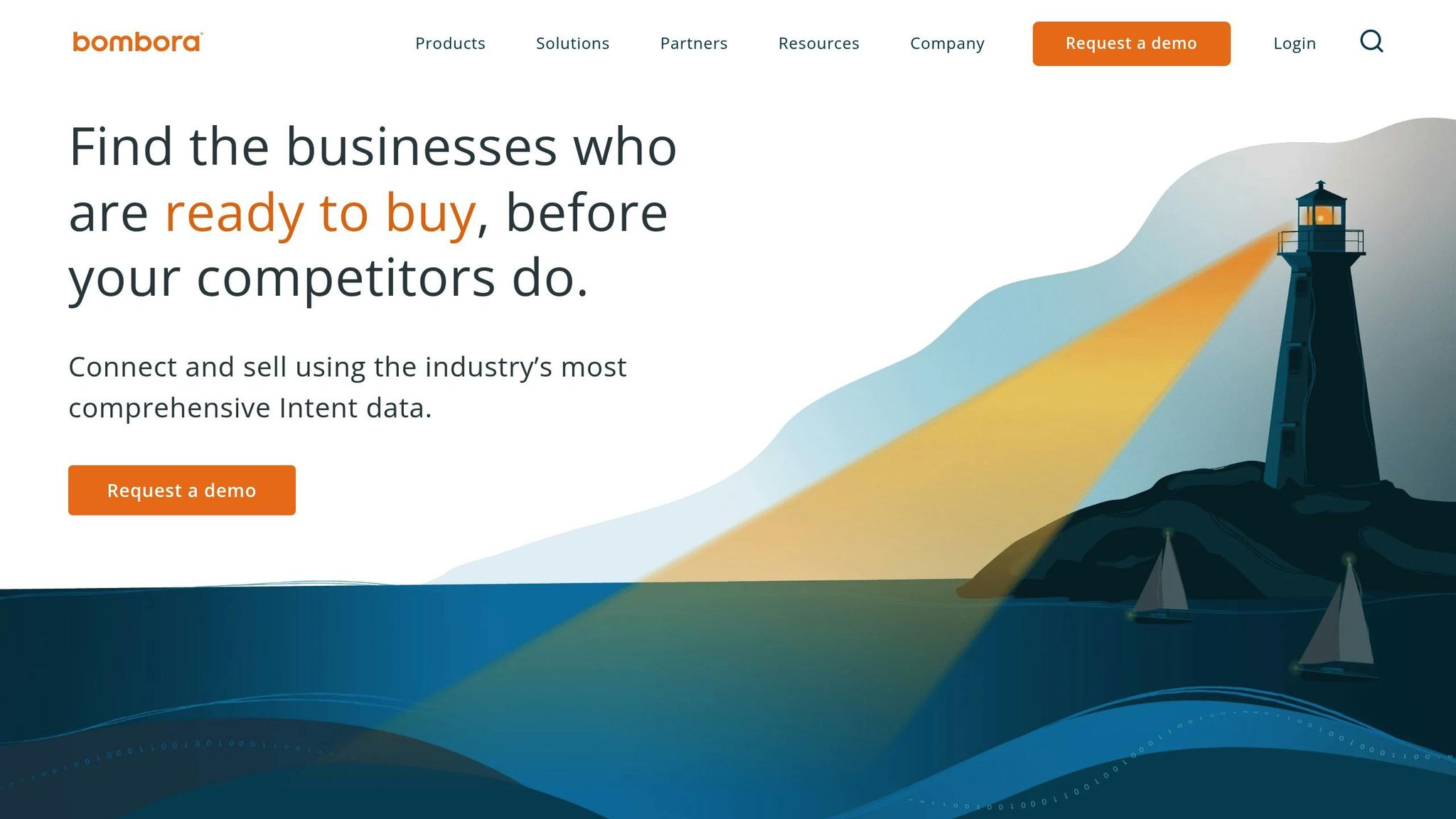
Bombora takes intent data to the next level by analyzing behavior across thousands of B2B platforms, giving businesses a deeper understanding of potential buyers' interests.
This B2B intent data platform tracks customer behavior across more than 5,000 B2B websites to pinpoint companies actively researching specific products or services. Unlike traditional lead generation tools, Bombora focuses on the broader organizational digital footprint rather than just individual actions.
What makes Bombora stand out is its cooperative data model, where 86% of its network websites share data exclusively. This exclusivity allows Bombora to provide a detailed view of how organizations consume content, making its tracking capabilities especially powerful.
Tracking and Machine Learning
Bombora uses advanced machine learning algorithms to monitor B2B behavior and identify potential buyers. These algorithms organize intent topics, ensuring the data remains actionable and relevant. To keep insights fresh, Bombora updates all its data weekly.
Another key differentiator is Bombora’s commitment to ethical data collection, relying on consent-based frameworks to ensure privacy and compliance.
Results That Speak for Themselves
Bombora delivers measurable outcomes for businesses. Companies report a 35% boost in conversions and a 25% drop in acquisition costs. For instance, SAP achieved a 25% increase in sales-qualified leads and cut their sales cycle time by 30%. Similarly, a Cisco partner saw a 50% growth in their sales pipeline and a 20% rise in closed deals.
Integration with CRM Systems
Bombora integrates seamlessly with existing tech stacks. A notable example is its collaboration with Adobe in May 2025. This partnership allows users to activate Bombora’s Company Surge® Intent data directly through Adobe Real-Time CDP B2B Edition. By combining Bombora’s intent data with first-party and third-party data, businesses can create tailored segmentations for various go-to-market strategies.
Pricing for Enterprise Needs
Bombora’s pricing is positioned above the industry average. While specific pricing details aren’t disclosed, the platform is designed for enterprises with complex sales cycles rather than offering standardized packages. It’s particularly effective for Account-Based Marketing (ABM) teams, demand generation marketers, and large organizations. Businesses use Bombora to prioritize high-interest accounts, track prospects researching competitors, and craft personalized outreach. This specialized approach aligns with its focus on enterprise clients, setting the stage for the next tool in our list.
4. ZoomInfo
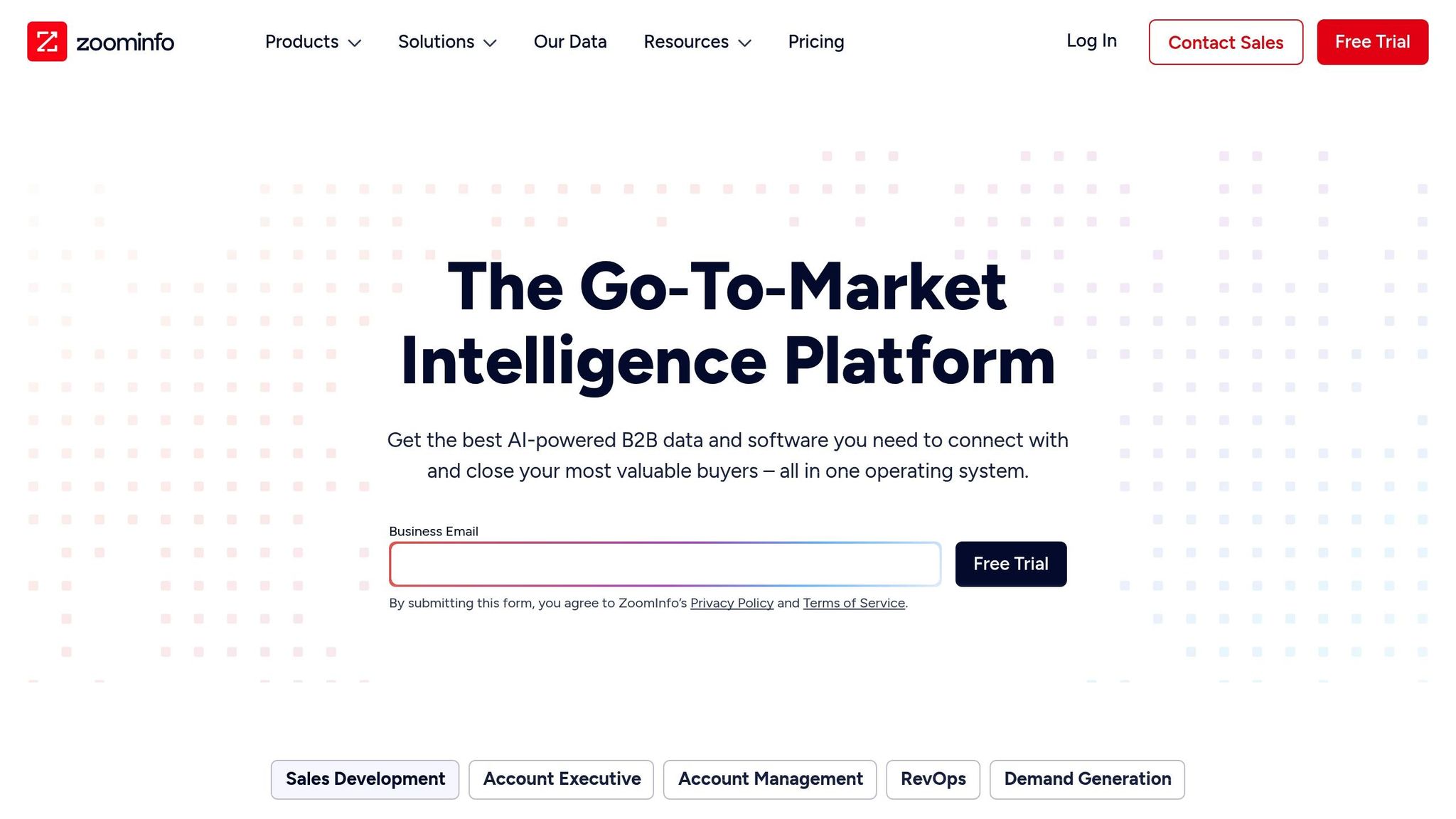
ZoomInfo stands out as a powerful tool for real-time customer intent prediction, offering advanced data capabilities to help sales and marketing teams respond swiftly to buying signals. By combining extensive data coverage with precise intent monitoring, ZoomInfo enables teams to identify prospects actively researching their solutions. The platform provides actionable insights from a database of over 104 million company profiles and 600 million contact profiles [30,32].
ZoomInfo tracks intent across more than 12,000 topics, leveraging data from a cooperative network of 5,000 B2B websites. This network captures online behaviors like reading product reviews, exploring informational content, comparing products, and consuming industry news - all of which help pinpoint accounts researching topics relevant to your business. This rich data foundation enhances its intent monitoring capabilities.
Intent Monitoring Capabilities
ZoomInfo’s intent monitoring tools are designed to capture a wide range of buying behaviors. The platform offers four types of intent data - derived, known, guided, and champion moves - to identify everything from content consumption patterns to influential decision-makers. Additionally, ZoomInfo Copilot synthesizes these intent signals to prioritize accounts and deliver tailored recommendations.
"Using ZoomInfo's 'intent' feature, I spotted a prospect that was researching my industry. I emailed the decision maker and closed the deal after one meeting. I made 25% of my yearly quota from that one intent signal!" – Capital One Customer
ZoomInfo’s intent monitoring doesn’t operate in isolation - it integrates seamlessly with marketing tools to create efficient, data-driven workflows.
Integration with Marketing Platforms
ZoomInfo excels at integrating with CRM, sales, and marketing platforms, enabling automated workflows that enhance lead engagement. For instance, ZoomInfo Workflows can automatically upload contact information to CRM systems or add leads to email sequences as soon as intent signals are detected, saving time and boosting productivity [30,35].
"Reliable data is the backbone of any high-performing sales organization. With ZoomInfo, we've automated critical processes, reduced inefficiencies, and improved prospecting accuracy - allowing our teams to focus on high-value opportunities instead of manual data management." – Rob Giglio, Chief Customer Officer, Canva
These integrations ensure that sales and marketing teams can act on insights quickly, turning intent data into meaningful engagement opportunities.
Cost Considerations
ZoomInfo’s pricing is tailored to enterprise needs, requiring prospects to schedule a demo for detailed information. The platform operates on a credit-based model, which may limit access to certain contacts [37,38]. The ZoomInfo SalesOS packages include:
- ZoomInfo Copilot Pro: $14,995/year
- ZoomInfo Copilot Advanced: $24,995/year
- ZoomInfo Copilot Enterprise: $32,995/year
All plans require a minimum two-year commitment. Additional features like Custom Intent Data start at $7,500/year, while API access for lead generation begins at approximately $50,000 annually [37,38].
Primary Applications for Sales and Marketing Teams
Sales and marketing teams rely on ZoomInfo’s intent data to identify interest, create targeted lists, personalize outreach, prioritize leads, and engage with confidence. The platform’s combination of standard and custom intent topics provides visibility into accounts most likely to convert. However, it’s not without challenges - 48% of users reported false positives in intent signals, leading to wasted effort, while 32% cited outdated firmographic data as an issue, especially when relying on funding-related insights.
ZoomInfo is a robust tool for organizations ready to invest in its capabilities. While it works best when integrated with existing CRM insights, its features can significantly enhance prospecting and engagement efforts for teams equipped to leverage its potential.
sbb-itb-5174ba0
5. Demandbase (including LeadSift)
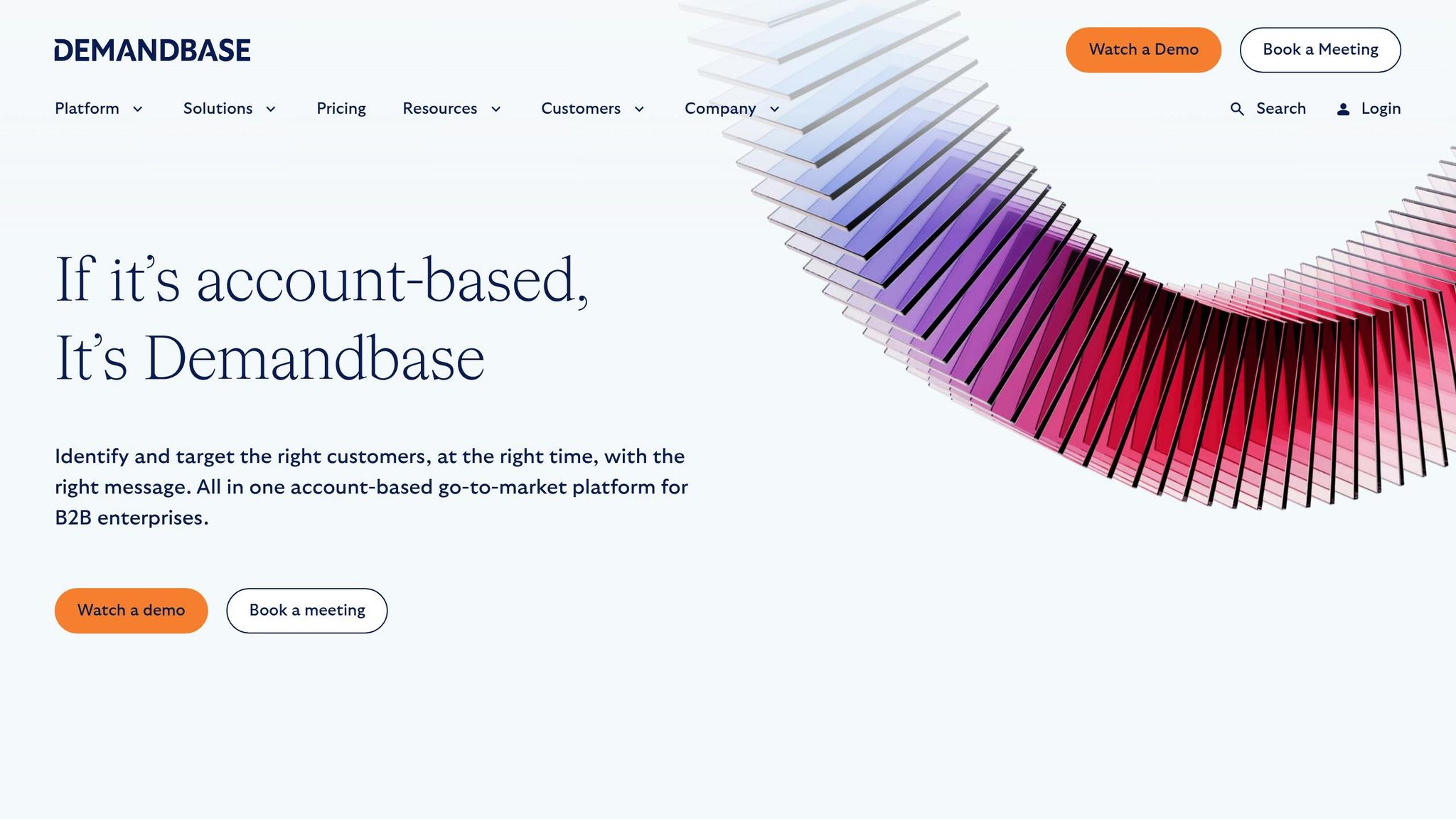
Demandbase stands out by combining large-scale data analytics with real-time insights to supercharge account-based marketing (ABM) strategies. Its AI-powered platform processes over 1 trillion monthly interactions from B2B companies, tracking 4 billion IP addresses and 36 billion B2B site visits annually. By tapping directly into the bidstream through its B2B DSP, Demandbase connects with over one million web publishers, capturing intent signals as they occur. This massive data pipeline fuels the platform's ability to analyze buyer behavior with remarkable precision.
Using AI, Demandbase identifies companies that align with your Ideal Customer Profile (ICP) by spotting activity spikes that reveal potential opportunities. Its natural language processing scans articles across 3 million websites, leveraging a vocabulary of more than 650,000 keywords to detect subtle buying signals that others might overlook.
"With real-time insights from over 1 trillion monthly interactions across 650,000+ intent keywords, your team can now prioritize the leads most likely to convert." - Bill Cao, Principal Product Manager, Demandbase
Real-Time Intent Monitoring Features
Demandbase’s "Trending Intent" feature highlights spikes in intent signals over a 7-day period. This real-time tracking, updated weekly, enables sales and marketing teams to act quickly on emerging buying signals instead of waiting for delayed batch reports.
The platform measures intent strength by analyzing how many individuals at similarly sized companies are engaging with web pages tied to specific keywords. This method ensures intent scoring is more accurate by factoring in company size and industry nuances. Demandbase collects data from diverse sources, including public business registries, B2B content consumption, and interactions on your own website.
A standout feature is its 13 months of historical intent data, which helps users uncover long-term trends and seasonal patterns in buyer behavior. Additionally, the platform supports 133 languages, making it a valuable tool for global teams tracking intent across various markets.
Marketing Platform Integration and ABM Applications
Demandbase integrates seamlessly with Salesforce, feeding real-time intent data directly into the Salesforce Prospecting Center. This integration streamlines workflows, allowing sales teams to access actionable insights without switching between platforms.
The Account Intelligence feature combines internal data with third-party insights to uncover hidden intent patterns. This is particularly useful for ABM strategies, where understanding the buyer journey across multiple touchpoints is crucial.
"Demandbase is a great tool to move your targeting from a one-to-many to a one-to-one and do some true ABM tactics. Working with your sales teams and then this tool, you can truly target the leads that your sales team is looking to get into, or even better, help them move through the pipeline by targeting your opportunity accounts." - Michael R., Marketing Manager, Enterprise
For advertising, Demandbase uses dynamic bidding based on intent signals, ensuring marketing budgets focus on high-intent prospects rather than broad demographic targeting.
Pricing Structure and Investment Considerations
Demandbase operates on a custom pricing model, requiring direct consultation with their sales team for quotes. The platform encourages full adoption rather than piecemeal options, which can lead to higher upfront costs but delivers a complete ABM solution.
Annual costs range from around $18,000 for smaller teams to over $100,000 for larger enterprises. The ABX Digital Bundle, which includes Engagement Platform and Audience Management, typically costs about $60,000 annually. While the lack of transparent pricing might require additional justification to stakeholders, many organizations find the investment worthwhile for the platform’s comprehensive capabilities. Pricing includes a core platform fee plus a flat per-user cost.
Primary Use Cases for Sales and Marketing Teams
Demandbase is particularly effective in driving revenue through key use cases. Teams can use it to:
- Find new accounts: Identify prospects outside the CRM with recent onsite engagement and keyword activity.
- Target the right people: Locate contacts at target accounts based on job title, level, and role.
- Prioritize accounts: Focus on accounts with recent intent and marketing engagement activity to refine target lists.
- Spot competitor research: Filter for accounts showing interest in competitor-related keywords to uncover actionable opportunities.
"The Demandbase platform is the perfect ABX engine to help companies understand intent and not just spam potential customers with unwanted emails - to really help you focus and look at where your buyers are along the journey and to support their education." - Linda Johnson, Global Director of Marketing Operations
Success stories showcase Demandbase’s impact. For example, Workforce Software reported a 121% increase in in-market Account Engagement within six months of using the platform. This highlights how its comprehensive intent data and ABM features can significantly boost pipeline growth and engagement metrics.
Demandbase is best suited for organizations deeply invested in ABM strategies and ready to commit to a full-platform approach. While the pricing may require careful consideration, its extensive data capabilities and real-time insights make it a powerful tool for targeting high-value accounts effectively.
6. Lead Forensics
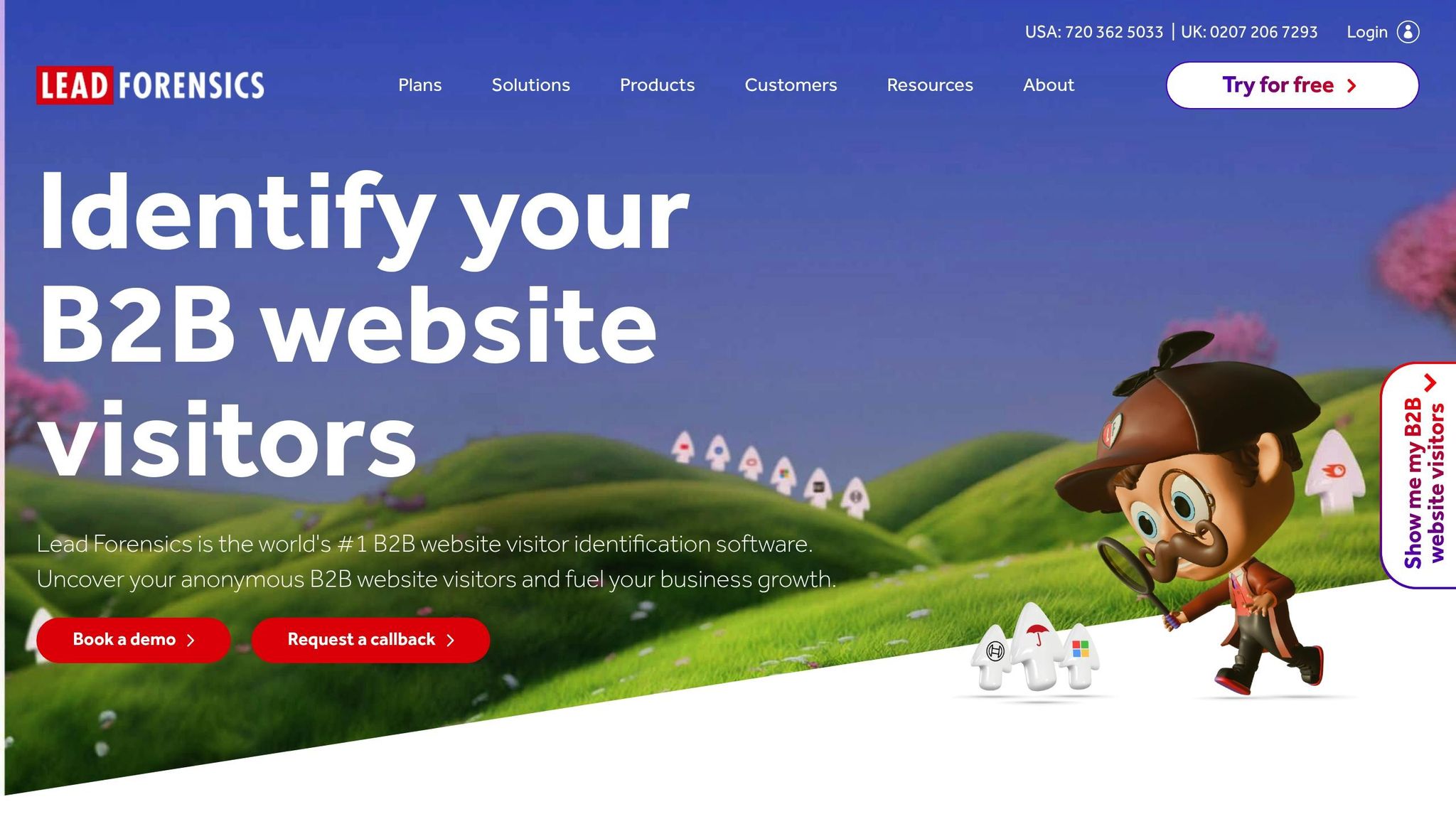
Lead Forensics takes customer intent prediction to the next level by identifying anonymous website visitors. While most companies only gather data from the small 2% of visitors who fill out contact forms, Lead Forensics uses its B2B-matched IP address database to uncover the identities of the other 98%. This turns ordinary website traffic data into actionable insights, giving sales teams the tools to convert anonymous visitors into real prospects.
The platform tracks key visitor behaviors - like pages viewed, time spent, and clicks - to gauge engagement. With real-time alerts notifying sales teams when potential customers are browsing, it allows for timely outreach when interest is at its peak.
Visitor Intelligence and Contact Discovery Features
Lead Forensics provides contact details for key decision-makers, including phone numbers, email addresses, and LinkedIn profiles. By submitting your Ideal Customer Profile (ICP) data, you can receive instant notifications when target businesses visit your site. Additionally, the software segments visitors by firmographics, making it easier to focus on leads that align with your goals.
"This is gold dust and is such a powerful tool for lead generation, I would strongly recommend to any company looking to generate new business."
- Stuart, Sales Director, Renewables & Environment
These insights can be seamlessly integrated into your CRM for smoother workflows and better lead management.
CRM Integration and Workflow Automation
Lead Forensics integrates with major CRMs like Salesforce, Microsoft Dynamics, HubSpot, and Gold-Vision, offering both one-way and two-way synchronization options. For example, its Salesforce integration transforms previously anonymous visitors into detailed sales leads, complete with contact information, demographics, and company data. Users can also choose which visitors or visit types to import, helping to avoid data overload and focus on high-value prospects. This real-time data transfer ensures that sales teams can act quickly on leads showing strong intent.
Parry and Evans, for instance, achieved a 12% conversion rate by combining Lead Forensics with their HubSpot CRM. This integration also supports targeted email campaigns and helps re-engage lapsed customers.
Pricing Structure and Value Assessment
Lead Forensics uses a traffic-based pricing model, with costs determined by your monthly website traffic. It offers two plans - Essential and Automate - both requiring an annual contract with unlimited user access. Pricing ranges from $6,000 to $98,000 per year, with an average cost of about $35,000. While the price point is on the higher side, the company claims that its platform can help close deals at five times the rate of traditional cold outreach methods.
User opinions on pricing vary. Some have expressed concerns about annual price increases without corresponding software enhancements, while others praise the platform for delivering actionable insights. As one user shared:
"Lead Forensics has given us actionable insight on our marketing activities that we would otherwise have not had visibility of...Critically, the tool provides visibility of marketing spend that is working, without form fills. This means we can adjust our efforts to encourage that and invest further in what we can see is gaining interest."
- Phil F., CMO
Effectiveness for Lead Generation Teams
Lead Forensics holds an overall rating of 4.4 out of 5 stars based on 179 Capterra reviews. Users rate its ease of use at 4.4/5, customer service at 4.6/5, and value for money at 4.2/5. The platform is particularly effective at identifying businesses that engage with your website but don’t complete contact forms, turning these otherwise invisible visitors into warm leads. Some users, however, have noted challenges in identifying the right contacts within large organizations, as well as occasional delays in loading visitor data.
Lead generation teams often find success by prioritizing high-value leads using touchpoint scoring and refining their strategies based on visitor industries and niches. With real-time notifications, teams can reach out to prospects while they’re still actively engaged, significantly improving connection rates compared to delayed follow-ups.
For businesses struggling with low form completion rates, Lead Forensics provides a way to turn anonymous website traffic into clear, actionable sales opportunities.
7. Triblio ABM Platform
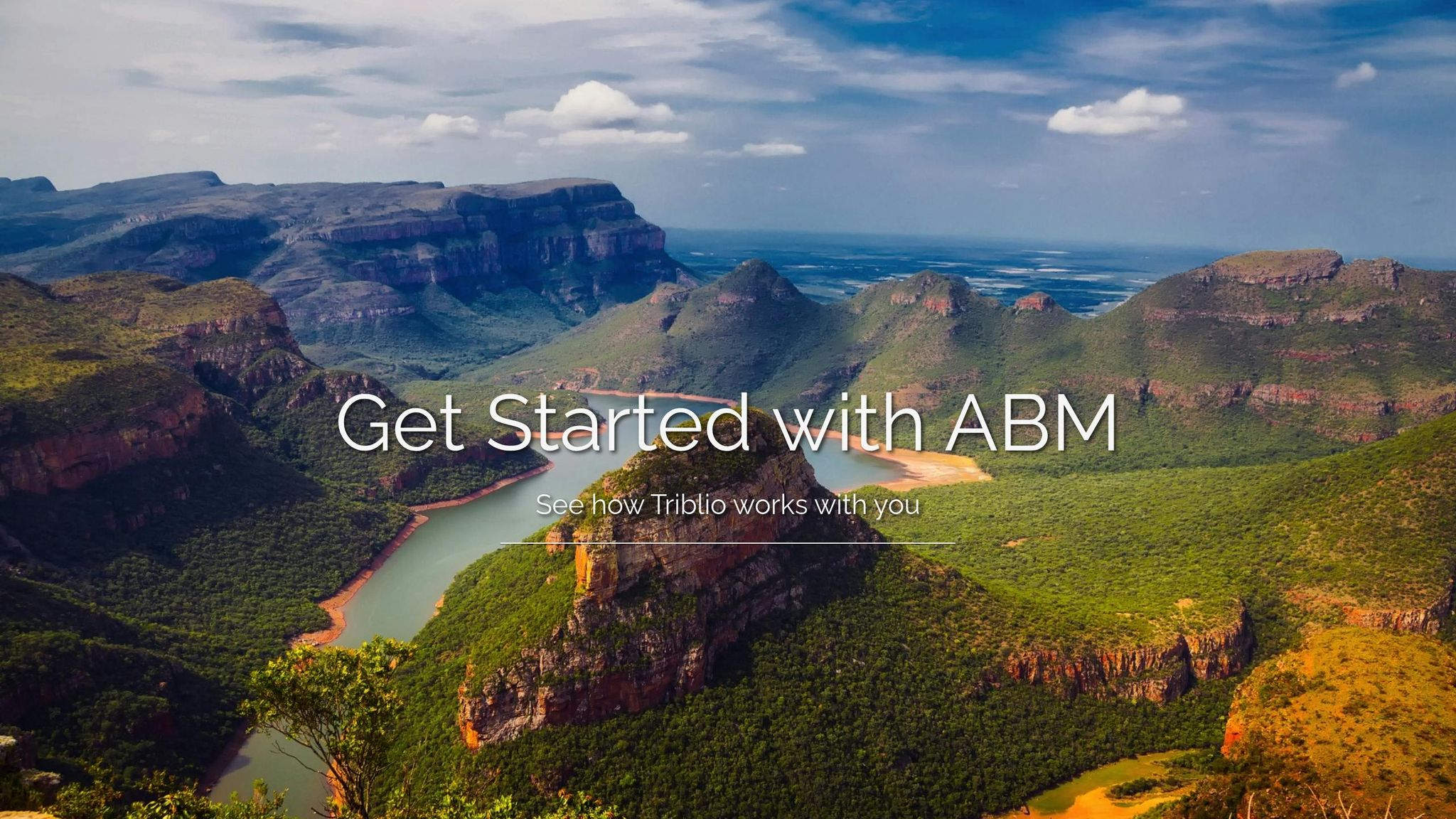
Triblio ABM Platform wraps up our list as a robust account-based marketing (ABM) tool that uses AI to analyze intent data and pinpoint accounts showing strong buying signals. By integrating with Foundry, it merges intent data with first-party insights, creating a dynamic system for predicting customer behavior in real time [45, 62].
What sets Triblio apart is its massive data reservoir - 175 million global profiles and 5 billion monthly interactions fuel its intent prediction capabilities. This rich dataset enables Triblio to identify which accounts are actively in-market and ready to engage with your sales team. Like other platforms we've covered, Triblio uses AI to turn raw data into actionable insights, helping businesses refine their ABM strategies.
Intent Signal Detection and Account Intelligence
Triblio's AI-driven system scans digital activity across the web to detect intent signals from target accounts. It goes beyond simple website tracking by analyzing what prospects are researching across multiple channels. Using anonymous matching, it tracks both known and unknown website visitors, scoring their activities to gauge intent [62, 69].
Businesses using Triblio's intent data have reported impressive results, including a 20% increase in deal size and a 70% boost in conversion rates. The platform also helps sales teams focus their outreach on accounts most likely to convert, making their efforts more effective [61, 63].
Marketing Automation and CRM Integration
Triblio doesn’t stop at intent detection. It seamlessly integrates with major CRM systems and marketing automation tools, providing detailed account insights while supporting multi-channel campaigns through platforms like Google Ads and LinkedIn. These integrations simplify workflows and have been shown to drive a 14.5% boost in productivity and a 20% increase in new sales opportunities [65, 67].
Pricing and Features
Triblio doesn’t publish its pricing details, so businesses need to contact them for a quote. Typically, ABM platforms range from $1,000 to $5,000 per month, with enterprise solutions costing more. Triblio offers features like display ads with contact and IP targeting, personalized website messaging, and sales activation tools that provide insights across digital channels. It also includes a user-friendly drag-and-drop interface for managing multi-stage ABM campaigns.
User Experience and Performance
Triblio earns high marks from users, with ratings of 4.3/5 on G2, 8.5/10 on TrustRadius, and 4.4/5 on Gartner. Users appreciate its ease of use, targeting options, and detailed reporting. Its straightforward setup and multi-channel engagement capabilities make it a strong choice for scaling ABM efforts. However, some users have noted slower initial report generation and occasional session management glitches that can impact load times.
For businesses committed to ABM strategies, Triblio's blend of intent data insights, multi-channel campaign management, and real-time sales intelligence offers a solid platform for identifying and acting on customer intent signals.
Tool Comparison Chart
Choosing the right tool for your business depends on factors like size, budget, and specific needs. The table below breaks down seven popular options to help you decide.
| Tool | Best For | Key Strengths | Pricing Range | Target Business Size |
|---|---|---|---|---|
| MeetRecord | Sales teams needing conversation insights | AI-powered call analysis, CRM integration | Contact for quote | Small to mid-sized businesses |
| UpLead | Lead generation and prospecting | Email verification, contact database | $74-$299/month | Small to enterprise |
| Bombora | Third-party intent data | B2B intent signals, 35% conversion rate increase | Contact for quote | Mid-sized to enterprise |
| ZoomInfo | Sales intelligence and prospecting | Extensive contact database, CRM integration | ~$15,000+/year | Mid-sized to enterprise |
| Demandbase | Account-based marketing | ABM platform integration, 25-30% conversion boost | $1,000+/month | Enterprise |
| Lead Forensics | Website visitor identification | Real-time visitor tracking, lead scoring | Contact for quote | Mid-sized businesses |
| Triblio ABM Platform | ABM-focused organizations | 175M profiles, 70% conversion rate boost | Contact for quote | Mid-sized to enterprise |
This chart complements the tool reviews provided earlier, helping you align their capabilities with your business goals. The right tool can significantly impact your campaign performance and real-time responsiveness.
When making your decision, think beyond features. Consider factors like ease of integration, pricing transparency, and the scalability of the platform. For instance, UpLead offers straightforward monthly pricing starting at $74, making it accessible for smaller businesses. In contrast, tools like Bombora, Demandbase, and Lead Forensics provide custom pricing, which may require a more detailed budget review. All tools support integration with major CRMs, though the depth of integration varies.
Another key consideration is industry focus. Some tools, like ZoomInfo and UpLead, cater to a broad range of sectors, while others, such as Demandbase, are tailored for specific use cases like account-based marketing. Notably, companies leveraging intent data are 2.5 times more likely to exceed sales goals, underscoring the importance of selecting the right platform.
For more in-depth comparisons, the Marketing Analytics Tools Directory is a valuable resource. It provides insights into real-time analytics, campaign tracking, and audience data, empowering businesses to refine their marketing strategies using data-driven methods.
Additionally, assess implementation timelines and your team's technical capacity. Simpler tools like UpLead can be up and running in days, while advanced ABM platforms may require weeks of setup. Factor in future growth and your technical resources to ensure the tool you choose supports your long-term objectives.
Conclusion
Choosing the right real-time customer intent prediction tool can make a huge difference in your marketing and sales performance. Studies show that using intent data can increase lead conversion rates by 37%, lower acquisition costs by up to 25%, and improve predictive accuracy for B2B purchases by 3.7 times.
The best tool for your business depends on factors like company size, budget, and specific needs. For smaller businesses with tighter budgets, platforms like UpLead offer an affordable starting point, with plans starting at $99/month. Mid-sized companies may find that tools like Lead Forensics or MeetRecord strike the right balance between features and scalability. Larger enterprises with complex sales processes often benefit from the advanced capabilities of Demandbase or ZoomInfo, though these come at a higher price.
Your industry focus also plays a role. Software and SaaS providers often gain the most from review-based intent data, while global companies serving enterprise clients typically require tools with international coverage.
Structured workflows supported by these tools can boost lead-to-opportunity conversion rates by 35–45%. Additionally, platforms can increase overall conversion rates by 25% and shorten sales cycles by 30%. These improvements are critical, especially as 75% of B2B buyers now expect personalized experiences from vendors. The right tool helps deliver this personalization at scale, giving your business a competitive edge.
For those looking to dive deeper, the Marketing Analytics Tools Directory offers detailed information on real-time analytics and campaign tracking solutions. This resource can help you evaluate how these tools fit into your existing marketing technology stack. With intent data becoming a strategic necessity for B2B companies, making an informed choice is more important than ever.
FAQs
How do these tools work with CRM systems to improve real-time customer intent prediction?
Real-time customer intent prediction tools connect seamlessly with CRM systems through APIs or built-in data connectors. This integration ensures smooth data sharing and enables workflow automation. With live intent data feeding directly into the CRM, businesses can trigger personalized actions like customized offers or follow-up tasks right within the platform.
When CRM data is combined with AI-powered insights, it unlocks a richer understanding of customer behavior. This not only sharpens predictive accuracy but also enhances customer profiles, empowering businesses to craft more precise and impactful engagement strategies.
What’s the difference between account-based marketing platforms like Demandbase and general lead generation tools like UpLead?
Account-based marketing (ABM) platforms, like Demandbase, are tailored to engage specific, high-value accounts through highly customized marketing campaigns. These platforms are all about building meaningful connections with individual companies, making them a perfect fit for businesses that focus on a select group of prospects.
In contrast, general lead generation tools such as UpLead are designed to cast a wider net. They enable businesses to gather a large number of potential leads using scalable outreach strategies that don’t focus on individual accounts. Simply put, ABM platforms focus on precision and personalization, while lead generation tools emphasize scale and reach.
How can businesses evaluate if real-time intent prediction tools are boosting sales conversions?
Businesses can measure how real-time intent prediction tools affect sales conversions by focusing on a few key metrics. Start with conversion rate improvements - this shows how well potential leads are being transformed into actual customers. Another important metric is the signal-to-conversion rate, which indicates how accurately these tools identify and respond to buyer intent.
You can also look at shifts in average deal size and overall sales growth. These figures can shed light on how these tools impact purchasing decisions. By keeping an eye on these metrics over time, businesses can gauge whether the tools are delivering meaningful sales results.

